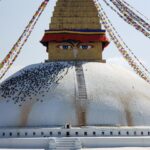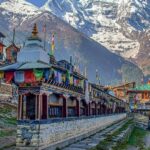Introduction
The Buddha Stupa, widely known as Boudhanath Stupa, is one of Nepal’s most iconic spiritual landmarks. Located in Kathmandu, it is a UNESCO World Heritage Site and one of the largest spherical stupas in the world. Famous for its towering white dome, golden spire, and Buddha’s all-seeing eyes, it attracts pilgrims, tourists, and spiritual seekers from around the globe.
- Introduction
- History of Buddha Stupa
- Fascinating Facts About Buddha Stupa
- Timeline of Buddha Stupa
- Significance of Buddha Stupa
- 1. Religious Significance
- 2. Cultural Importance
- 3. Architectural Value
- 4. Tourism & Economy
- 5. Spiritual & Educational Role
- 6. Peace Symbol
- Observance & Cultural Activities
- Wishing at Buddha Stupa
- Daily Life Impact
- FAQs About Buddha Stupa
- Important Tips for Visitors
- Importance in Society
- Conclusion
For travelers looking for cheap vacation ideas with deep cultural and spiritual experiences, Buddha Stupa is an ideal destination. It offers not only serenity and devotion but also opportunities for photography, meditation, and learning about Nepalese and Tibetan culture.
This guide covers history, fascinating facts, timeline, significance, observance, wishing, FAQs, daily life impact, and societal importance in a human-friendly and engaging style.
History of Buddha Stupa
Ancient Origins: Legends suggest that the stupa was originally built in the 5th century CE during the reign of King Manadeva.
Religious Center: Over centuries, it became a central hub for Tibetan Buddhism and a place of pilgrimage for both Hindus and Buddhists.
Tibetan Influence: The influx of Tibetan refugees in the 1950s transformed the area into a vibrant Tibetan cultural and monastic center.
Restoration: The stupa has undergone several restorations, including after the 2015 earthquake, ensuring its preservation and continued spiritual relevance.
UNESCO Recognition: Listed as a World Heritage Site in 1979, highlighting its global cultural and spiritual importance.
Fun Fact: The stupa’s dome represents the earth, the spire symbolizes the 13 stages of enlightenment, and Buddha’s eyes reflect wisdom and compassion.
Fascinating Facts About Buddha Stupa
Largest Spherical Stupa: Standing at about 36 meters in height, it is one of the largest of its kind globally.
All-Seeing Eyes of Buddha: Depicted on all four sides of the tower, symbolizing awareness, compassion, and spiritual vigilance.
Prayer Wheels: Hundreds of prayer wheels surround the stupa, which devotees spin while circumambulating clockwise.
Monastic Hub: Houses multiple Tibetan monasteries (gompas) and is a center for Buddhist learning and rituals.
Cultural Festivals: Hosts important celebrations such as Buddha Jayanti and Tibetan New Year (Lhosar).
Symbol of Peace: A focal point for meditation, reflection, and spiritual growth.
Tourist-Friendly: Accessible to visitors, offering cafes, handicraft shops, and guided tours for an immersive experience.
Photography Hotspot: Popular for capturing sunsets, ritual activities, and the mesmerizing stupa itself.
Spiritual Learning: Provides visitors with insights into Buddhism, Newar art, and Tibetan culture.
Timeline of Buddha Stupa
5th Century CE: Original construction during King Manadeva’s reign.
14th Century: Became a hub for traders and Buddhist pilgrims.
1950s: Tibetan refugees settled in the area, building monasteries.
1979: Recognized as a UNESCO World Heritage Site.
2015: Earthquake caused damage; restoration preserved its historical and spiritual value.
Present: Continues to be a center for worship, tourism, and cultural exchange.
Significance of Buddha Stupa
1. Religious Significance
Buddha Stupa is one of Nepal’s most sacred Buddhist sites, where pilgrims perform kora (circumambulation) while chanting mantras and spinning prayer wheels.
2. Cultural Importance
It represents the fusion of Newar and Tibetan cultures, preserving centuries-old rituals, festivals, and traditional architecture.
3. Architectural Value
The stupa features traditional Buddhist design elements: a white dome, golden spire, and symbolic mandalas, each representing spiritual teachings and enlightenment.
4. Tourism & Economy
Supports local businesses, handicrafts, restaurants, and guided tours, contributing significantly to Kathmandu’s tourism sector.
5. Spiritual & Educational Role
Provides learning opportunities about Buddhism, meditation, and Himalayan cultural practices for both locals and international visitors.
6. Peace Symbol
Represents inner peace, harmony, and wisdom, attracting those seeking spiritual rejuvenation.
Observance & Cultural Activities
Buddha Jayanti: Celebrates the birth, enlightenment, and death of Buddha with prayers, butter lamps, and processions.
Tibetan New Year (Lhosar): Monks and locals perform ritual dances, prayers, and community gatherings.
Daily Rituals: Monks chant, light butter lamps, and devotees spin prayer wheels throughout the day.
Workshops & Meditation: Some monasteries organize meditation sessions and cultural learning programs for visitors.
Wishing at Buddha Stupa
Visitors often make wishes while circumambulating, spinning prayer wheels, or lighting butter lamps:
🕉️ “May my mind be filled with wisdom, peace, and compassion.”
🌸 “Wishing for happiness, harmony, and spiritual growth for all beings.”
🏔️ “May this sacred place guide me towards clarity, mindfulness, and enlightenment.”
These acts connect visitors with Buddhist spiritual practice, enhancing their emotional and cultural experience.
Daily Life Impact
Buddha Stupa significantly affects locals and tourists:
For Tourists: Provides opportunities for meditation, spiritual learning, cultural immersion, and photography.
For Locals: Supports monks, shopkeepers, guides, and hospitality services, sustaining livelihoods.
For Society: Encourages heritage preservation, spiritual education, and intercultural understanding.
Students and young visitors learn about Buddhism, Nepalese culture, and religious tolerance, fostering personal growth and awareness.
FAQs About Buddha Stupa
Q1: When is the best time to visit?
A: Early morning or late afternoon for a serene atmosphere and best lighting.
Q2: Is there an entry fee?
A: Yes, a nominal fee supports maintenance and restoration.
Q3: Can I take photographs?
A: Photography is allowed; avoid using flash near worshippers or inside monasteries.
Q4: How long should I spend here?
A: 1–2 hours to explore the stupa, monasteries, and surrounding area.
Q5: Are guided tours available?
A: Yes, guides explain history, symbolism, and spiritual significance of the stupa.
Important Tips for Visitors
Dress modestly and respectfully.
Walk clockwise while spinning prayer wheels.
Maintain silence and respect ritual activities.
Avoid touching sacred objects unnecessarily.
Carry water, sun protection, and a camera.
Importance in Society
Buddha Stupa serves as a spiritual, cultural, and economic cornerstone:
Religious Preservation: Maintains centuries-old Buddhist practices.
Cultural Significance: Promotes Newar and Tibetan heritage.
Economic Role: Supports local artisans, guides, and businesses.
Educational Value: Provides insight into Buddhism, art, and Himalayan culture.
Community Cohesion: Encourages respect, harmony, and spiritual practice among locals and visitors.
Conclusion
Buddha Stupa is not just a monument; it is a living symbol of faith, culture, and inner peace. Accessible, serene, and visually striking, it provides travelers with a deeply spiritual and culturally enriching experience.
🕉️ Wishing for You: May your visit to Buddha Stupa inspire wisdom, tranquility, and connection to humanity’s shared spiritual heritage. Let every prayer wheel, butter lamp, and gaze of Buddha guide your journey toward enlightenment, harmony, and cultural appreciation.








